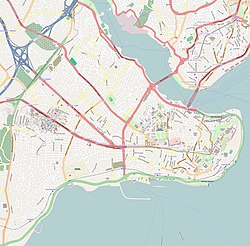Cistern of Pulcheria
Κινστέρνα Πουλχερίας | |
| Location | Istanbul |
|---|---|
| Coordinates | 41°01′30″N 28°57′00″E / 41.025°N 28.95°E |
| History | |
| Builder | Aelia Pulcheria |
| Founded | 421 AD |
| Site notes | |
| Condition | abandoned |
| Public access | no |
The Cistern of Pulcheria (Greek: Κινστέρνα Πουλχερίας, Turkish: Pulcheria Sarnıcı) is a Byzantine period covered cistern built in Constantinople (modern Istanbul, Turkey).
Description
This cistern lay in the eleventh region of
According to the
The reservoir is one of the best well-kept in Istanbul.[2] It should have belonged to a palace, which has not survived.[5] Its area covers 29.10 by 18.70 metres (95.5 by 61.4 ft). Its roof is supported by four rows of seven marble or granite columns, which bear 40 domes 8.50 metres (27.9 ft) above the ground. The columns have capitals of Corinthian order, surmounted with transoms carved with leaves of acanthus or bearing the symbol of the cross. The building has 35 windows, but now most of them are walled. Its main facade is features four windows of equal area with a door placed under the third window.[2]
See also
References
Citations
Bibliography
- Mamboury, Ernest (1953). The Tourists' Istanbul. Istanbul: Çituri Biraderler Basımevi.
- Janin, Raymond (1964). Constantinople Byzantine (in French). Paris: Institut Français d'Etudes Byzantines.
- OCLC 3747838.
Further reading
- Crow, J. (2015). "The Water Supply of Byzantine Constantinople". History of Istanbul. Retrieved January 15, 2021.
- Mango, Cyril (1995). "The Water Supply of Constantinople". In Mango, Cyril; Dagron, Gilbert (eds.). Constantinople and its Hinterland. Aldershot, Hampshire, UK: Ashgate Publishing. pp. 9–18. ISBN 9781315259567.
- Ward, K. A.; Crapper, M.; Altuğ, K; Crow, J. (2017). "The Byzantine Cisterns of Constantinople" (PDF). Water Supply. 17 (6). London: IWA Publishing: 1499–1506. .
- Angelova, Diliana. "Stamp of Power: The Life and afterlife of Pulcheria’s Buildings." In Byzantine Images and their Afterlives, pp. 105-126. Routledge, 2016.


